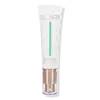Flower Beauty by Drew Skin Smoothie Power Matte Primer Versus Laura Geller Spackle Skin Perfecting Primer
What's inside
What's inside
 Key Ingredients
Key Ingredients

 Benefits
Benefits

 Concerns
Concerns

 Ingredients Side-by-side
Ingredients Side-by-side

Cyclopentasiloxane
EmollientWater
Skin ConditioningDimethicone
EmollientIsododecane
EmollientDimethicone/Vinyl Dimethicone Crosspolymer
Skin ConditioningTribehenin
EmollientCetyl PEG/PPG-10/1 Dimethicone
EmulsifyingSilica Dimethyl Silylate
EmollientDisteardimonium Hectorite
StabilisingPhenoxyethanol
PreservativeSodium Dehydroacetate
PreservativeAroma
Disodium EDTA
Tropolone
Skin ConditioningHelianthus Annuus Seed Oil
EmollientGlycerin
HumectantCamellia Sinensis Leaf Extract
AntimicrobialTocopheryl Acetate
AntioxidantThymus Vulgaris Leaf Extract
Skin ProtectingLimonene
PerfumingLinalool
PerfumingCitronellol
PerfumingCyclopentasiloxane, Water, Dimethicone, Isododecane, Dimethicone/Vinyl Dimethicone Crosspolymer, Tribehenin, Cetyl PEG/PPG-10/1 Dimethicone, Silica Dimethyl Silylate, Disteardimonium Hectorite, Phenoxyethanol, Sodium Dehydroacetate, Aroma, Disodium EDTA, Tropolone, Helianthus Annuus Seed Oil, Glycerin, Camellia Sinensis Leaf Extract, Tocopheryl Acetate, Thymus Vulgaris Leaf Extract, Limonene, Linalool, Citronellol
Water
Skin ConditioningGlycerin
HumectantTriethylhexanoin
MaskingIsodecyl Neopentanoate
EmollientCetyl Alcohol
EmollientGlyceryl Stearate
EmollientSimmondsia Chinensis Seed Oil
EmollientStearyl Alcohol
EmollientHelianthus Annuus Seed Oil
EmollientSilica
AbrasiveAcrylates/C10-30 Alkyl Acrylate Crosspolymer
Emulsion StabilisingTocopheryl Acetate
AntioxidantTocopherol
AntioxidantPolyglycerin-3
HumectantButyrospermum Parkii Butter
Skin ConditioningSodium Hyaluronate
HumectantButylene Glycol
HumectantCitric Acid
BufferingCamellia Oleifera Leaf Extract
AstringentCrithmum Maritimum Extract
Skin ConditioningPropanediol
SolventSodium Hyaluronate Crosspolymer
HumectantSqualane
EmollientOryza Sativa Bran Extract
Skin ConditioningHelianthus Annuus Extract
EmollientHydrolyzed Rice Bran Extract
Skin ConditioningAloe Barbadensis Leaf Extract
EmollientRosmarinus Officinalis Leaf Extract
AntimicrobialPolyglutamic Acid
Skin ConditioningSodium Hydroxide
BufferingTrisodium Ethylenediamine Disuccinate
Sodium Benzoate
MaskingCaprylyl Glycol
EmollientHexylene Glycol
EmulsifyingPhenoxyethanol
PreservativeWater, Glycerin, Triethylhexanoin, Isodecyl Neopentanoate, Cetyl Alcohol, Glyceryl Stearate, Simmondsia Chinensis Seed Oil, Stearyl Alcohol, Helianthus Annuus Seed Oil, Silica, Acrylates/C10-30 Alkyl Acrylate Crosspolymer, Tocopheryl Acetate, Tocopherol, Polyglycerin-3, Butyrospermum Parkii Butter, Sodium Hyaluronate, Butylene Glycol, Citric Acid, Camellia Oleifera Leaf Extract, Crithmum Maritimum Extract, Propanediol, Sodium Hyaluronate Crosspolymer, Squalane, Oryza Sativa Bran Extract, Helianthus Annuus Extract, Hydrolyzed Rice Bran Extract, Aloe Barbadensis Leaf Extract, Rosmarinus Officinalis Leaf Extract, Polyglutamic Acid, Sodium Hydroxide, Trisodium Ethylenediamine Disuccinate, Sodium Benzoate, Caprylyl Glycol, Hexylene Glycol, Phenoxyethanol
Ingredients Explained
These ingredients are found in both products.
Ingredients higher up in an ingredient list are typically present in a larger amount.
Glycerin is already naturally found in your skin. It helps moisturize and protect your skin.
A study from 2016 found glycerin to be more effective as a humectant than AHAs and hyaluronic acid.
As a humectant, it helps the skin stay hydrated by pulling moisture to your skin. The low molecular weight of glycerin allows it to pull moisture into the deeper layers of your skin.
Hydrated skin improves your skin barrier; Your skin barrier helps protect against irritants and bacteria.
Glycerin has also been found to have antimicrobial and antiviral properties. Due to these properties, glycerin is often used in wound and burn treatments.
In cosmetics, glycerin is usually derived from plants such as soybean or palm. However, it can also be sourced from animals, such as tallow or animal fat.
This ingredient is organic, colorless, odorless, and non-toxic.
Glycerin is the name for this ingredient in American English. British English uses Glycerol/Glycerine.
Learn more about GlycerinHelianthus Annuus Seed Oil is the oil derived from the seeds of a Sunflower. Sunflower seed oil is non-fragrant. It is an emollient, meaning it helps to soften the skin.
Sunflower seed oil contains many fatty acids. The fatty acids found in sunflower seeds include (from highest amount to least): linoleic acid, myristic acid, palmitic acid, stearic acid, arachidic acid, oleic acid, and linolenic acid.
These fatty acids help the skin create ceramides. Ceramides play a role in repairing the skin barrier.
Helianthus Annuus Seed Oil helps moisturize the skin. This in turn helps the skin look more rejuvenated and smoother.
Sunflowers are rich in vitamin E.
Historians believe Indigenous cultures of North America domesticated sunflowers before corn. Thus they relied on sunflower oil for a variety of uses. One such use is moisturizing skin and hair.
Sunflower seed oil may not be fungal acne safe. We recommend speaking with a professional if you have any concerns.
Learn more about Helianthus Annuus Seed OilPhenoxyethanol is a preservative that has germicide, antimicrobial, and aromatic properties. Studies show that phenoxyethanol can prevent microbial growth. By itself, it has a scent that is similar to that of a rose.
It's often used in formulations along with Caprylyl Glycol to preserve the shelf life of products.
Tocopheryl Acetate is AKA Vitamin E. It is an antioxidant and protects your skin from free radicals. Free radicals damage the skin by breaking down collagen.
One study found using Tocopheryl Acetate with Vitamin C decreased the number of sunburned cells.
Tocopheryl Acetate is commonly found in both skincare and dietary supplements.
Learn more about Tocopheryl AcetateWater. It's the most common cosmetic ingredient of all. You'll usually see it at the top of ingredient lists, meaning that it makes up the largest part of the product.
So why is it so popular? Water most often acts as a solvent - this means that it helps dissolve other ingredients into the formulation.
You'll also recognize water as that liquid we all need to stay alive. If you see this, drink a glass of water. Stay hydrated!
Learn more about Water